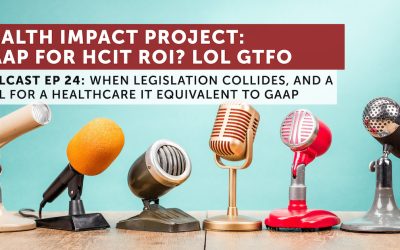
But is this really the best use of $1B?
Some would argue yes, we need to spend this kind of money to help disseminate best practices from leading healthcare organizations to those that are less skilled at preventing hospital acquired complications that put patients at risk. But is that not what AHRQ is suppose to do as part of its existing charter? And does not NIH and CDC also have some role to play here? Also, the recently released ACO proposed rules from CMS are looking to tackle this issue and one could even argue that the HITECH Act and Meaningful Use are structured to help address this issue as well. Which raises the question:
Do we really need another program to address the issue of patient safety or are we just adding another layer of bureaucracy and another pot of gold for various special interests groups to tap?
It may be heresy to ask these questions and maybe our questions are based more on ignorance, but this program just doesn’t seem to pass the sniff taste.
Rather then spend that billion dollars on yet another program that will be managed by beltway bandit contractors for HHS, would it not be better to develop programs similar to what is outlined in the ACO rules (but far simpler) that create incentives for healthcare organizations to go out on their own and find what will work best for them to improve patient safety. While we are at it, we can use a stick as well. Why not start publishing in the local papers say on a quarterly basis, quality reports on the nine areas that HHS wishes to see improvement in as part of this program. In our view there is nothing like bad publicity to ignite changes in behavior.
The more one thinks about the Partnership for Patients the more one begins to see it for what it truly is; a publicity stunt designed to create broad-based support for the Accountable Care Act for it certainly is not the most effective or efficient way to change current practices to improve patient outcomes.




Agreed. Look at 3M…their already starting to play it up!
http://solutions.3m.com/wps/portal/3M/en_US/infection-prevention-solutions/home/sterile-processing/SSI-reduction/
“They can help!”
Of course they can! I would too if I could take a piece of that pie!
What does 3M do?
I’m no expert in this landscape so I’ll only say, cautiously but with some firmness: regardless of anything else going on, I very much doubt we could overdo it in our efforts to reduce harm.
At the IHI Forum in December I was part of a group of patients who were invited to attend the entire conference. At the meeting get-together Saturday night, I heard dozens of truly appalling stories of medical errors. Real rip-your-heart out things – and most of them were not “These things happen” occasional accidents, they were gross systemic malfunctions.
Then I realized the impact of the Inspector General’s report in November, that the data shows 15,000 elders a month are accidentally killed in hospitals. And that’s just elders (Medicare patients).
I find myself remembering Barry Goldwater’s acceptance speech, nearly 50 years ago: “Extremism in the defense of liberty is no vice. And… moderation in the pursuit of justice is no virtue!” (Yes, Shim, I’m quoting Barry Goldwater!)
Do we think this rate of accidental death is not an emergency?
AND, having said that, I again don’t know the whole landscape. Just saying, avoidable deaths from avoidable complications are no small matter.
That’s just the point Dave of this whole post. No one can object to it, everyone can get behind it, all of us know someone who has been affected by a medical error but at the end of the day the Partnership for Patients really is nothing more than a publicity stunt. We didn’t intend to write the post in this manner (actually we’re thinking the antithesis to this post) but the more research we did, the more painfully obvious it became as to what this was really about, which is ultimately demeaning to the public.
Let’s just stop all the research and get on with making sure clinicians follow best practices. Lord knows AHRQ has shelves full of them.
LOL … if you have any idea on how to *enforce* that on docs, you may win a Nobel! (Seriously. Gawande for one would be out of business, and the IHI might cut its staff in half!)
I’m all ears – truly. (No matter how I try to write that it looks cynical, but you know I mean it sincerely.)